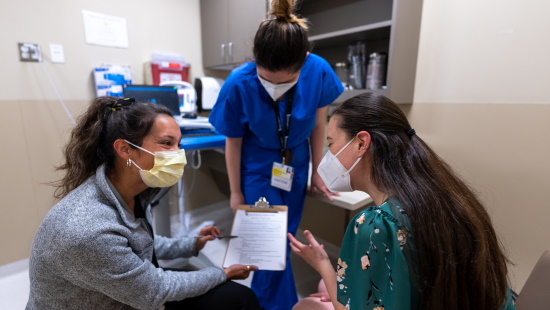
Brachytherapy

During brachytherapy — a type of localized internal radiation therapy for cancer — the sources of radiation are placed inside the body. Radioactive sources are placed on or in a tumor without affecting the surrounding tissue.
By placing the radiation sources in the body, we can better confine the radiation to the tumor.
These sources of radiation are in the form of small metal seeds (about the size of a grain of rice) or microscopic beads made of glass or resin. Alternatively, a catheter or device will be placed into the body or tumor temporarily to distribute the radioactive sources and then removed.
At University of Maryland, we use brachytherapy to treat cancers such as head and neck (including eye cancer), breast, gynecologic, prostate and liver.
Types of Brachytherapy
HDR or High Dose Rate Implants
In this form of brachytherapy, a radioactive source is temporarily placed in the body via a catheter or “tube”. This radioactive seed is in place for 1 to 20 minutes once or twice per day, depending on your condition.The tube may stay in place during the course of the treatment or be removed and reinserted for each treatment. This technique is typically used to treat prostate and gynecologic cancers.
HDR Brachytherapy for Skin Cancer
Both basal cell and squamous cell skin cancers that have not spread to other parts of the body can be treated effectively with HDR brachytherapy. Brachytherapy applicators are placed precisely and close to the cancerous cells, reducing treatment time and the amount of radiation to other healthy tissues. Superficial brachytherapy is a painless procedure that usually lasts only a few minutes per session without disrupting daily life. For certain larger tumors or skin cancer on the face, interstitial brachytherapy is often indicated.
LDR or Low Dose Rate Implants
With LDR, radioactive sources remain inside the body permanently. While these sources may remain in your body, the level of radioactivity diminishes rapidly and eventually goes to zero. There are some temporary restrictions for patients during this treatment.
Dr. Jason Molitoris explains how brachytherapy together with hyperthermia therapy can be an effective treatment for some prostate cancers.
Types of LDR include:
Prostate Seeds
Prostate seed therapy is a type of LDR brachytherapy that is currently being used at the University of Maryland to treat some prostate cancers either alone or in combination therapy with external radiation.
In this minimally invasive, outpatient procedure, the rice grain-sized seeds are placed within the prostate using ultrasound guidance. Having the sources confined to the prostate itself may help decrease the side effects associated with other treatments, such as erectile dysfunction or incontinence.
Radionuclide Therapy
In radionuclide therapy, microscopic spheres containing radioactive drugs can be injected and flow through the bloodstream directly to the tumor to treat primary and metastatic cancer. This is a way to treat liver cancer.
These radioactive drugs are designed to seek out specific cancer cells and bind to them. At that point, the radioactive material attached to the drug irradiates the cancer cells. The radiation is short-lived and loses its activity within days or weeks.
SIRT
Also called selective internal radiation therapy, SIRT treats liver cancer using permanently implanted radioactive glass or resin beads.
Make an Appointment
To make an appointment at UM Greenebaum Comprehensive Cancer Center in Baltimore, call 410-328-6080. Or, contact one of our other five radiation oncology locations in Central Maryland, Eastern Maryland and Prince George's County.



